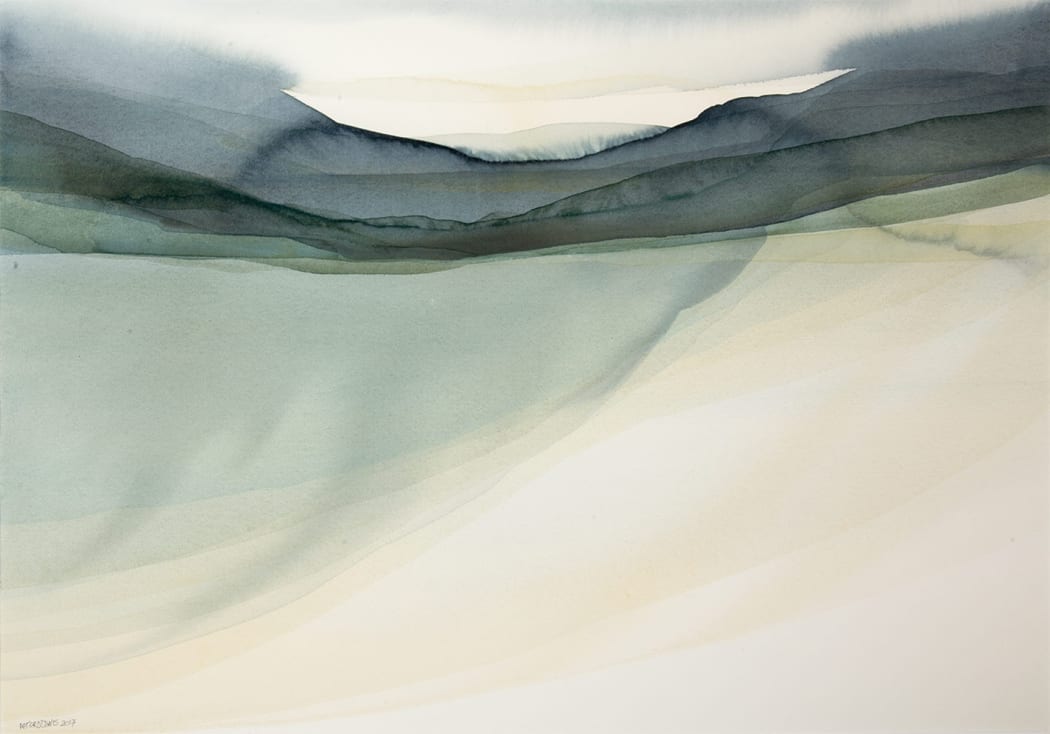
There’s a point at which the act of painting and the inherent action of nature align themselves and that frequently happens in watercolour. I consider it the most natural of all the painting mediums, comprising pigment, a binder which is mainly gum arabic, and water, the drying process leaving the pigment on the surface. Nothing could be simpler, apart from perhaps charcoal or chalk.
The two extremes of stillness and flow and the myriad activity between the two are what make watercolour, for me, the most natural medium with which to depict the extremes of the Northern landscapes. I have painted this subject for more than 35 years and it continues to provide a source of excitement and exploration.
Back in 1980 I took a boat trip out to the tiny island of Copinsay in Orkney. The gradual incline of rock coming out of the sea was an inspiration that came tumbling out as a series of dribbling watercolours in which pigment and water interacted and flowed suggesting but not depicting the land/seascape. It was in my mind a metaphor for what was taking place in nature, the interaction of water and pigment mirroring the sea water and rock.
Since then my work has developed from simple dribbling of paint to pools of slow drying colour. And this slowness is crucial. Patience is one of my least favourite virtues in everything except painting. A wash or a pool of any watercolour has to be left to dry naturally. The humidity in Shetland often means this drying process can take a day or more so I generally have several paintings on the go at once.
I have no wish to simply record what I see. I do not seek sedate topographies often associated with the term ‘watercolour landscapes’. Instead I prefer the uncertain balance between abstraction and reality. I want these paintings to be a distillation of the landscape in which the subject itself is so often watery. In the Northern isles it’s the sea and lochs as well as the weather that draws me. But equally so it is the geology, which brings me to pigment. Mostly what is left on the paper after a wash has dried and the water has evaporated are tiny fragments of earthy pigment, oxides in many cases, which accumulate in the textured hollows. Indeed the finished physical results of a painting are often a microcosm of the natural world on which they are based.

Watercolour plays by nature’s rules; it obeys gravity, in most cases, flows, puddles, desiccates, dries and sometimes fades. That has been its misfortune as a painting medium over the centuries. However most artists’ quality pigments now have a permanence that is equal to its rivals, oil and acrylic. And in capturing the relentless rain showers or banks of dark cloud over a threatening sea or the pure soft beauty of a still loch there’s nothing to compete with watercolour and its symbiotic relationship with that natural world. Just because watercolour’s surface and its paper support is less durable than the hard oiled and varnished surface of an oil painting or the plasticity of acrylic shouldn’t mean that it is treated like a less valuable painting form which is often the case. This is something that the artist Turner was well aware of. His elevation of watercolour from a medium of sketching into a highly finished state equal to oils is a case in point.
My approach to painting in watercolour has changed over the last three decades, developing in many ways. Although I still find ‘pure’ watercolour the most interesting and challenging, I have also employed gouache, spray bottles, scrubbing brushes, pipettes, airbrush and a number of different techniques including ice, raw pigment, and also chalk which not only adds highlights to the texture of the paper but also an element of movement over a dried wash. I begin as always with the idea of the stretched white paper surface already as part of the painting and then add coloured washes accordingly. This has removed any ‘fear’ of the white page that I might have had. In most cases I have a basic plan for the finished piece but the medium often has other ideas. I like the unpredictable quality of watercolour and sometimes you just need to ‘go with the flow’. Allowing one wash to dry before laying another, I build up an image that requires care and attention. So I do love watching paint dry.
I’m not a ‘plein air’ painter; my way of working requires a certain control over situations and for me the weather in Shetland is often just too unpredictable for that. I record my experiences outside through drawing and photography then go indoors to the studio and work. And being a control freak I need everything to hand.
There are many variables at work in watercolour painting. Amount and type of pigment, quantity and quality of water, size of brush, surface of paper, area of wash, etc. all affect the finished painting as does gravity. The stretched paper is often at different angles, washes pool, flow, or simply run off. There are also many chance elements, loads of happy accidents and good intentions and so many disasters. But when they work well there’s a magic that no oil or acrylic painting can ever match.
Together these variables enhance my approach to, and my re-presentation of, my chosen landscapes.
